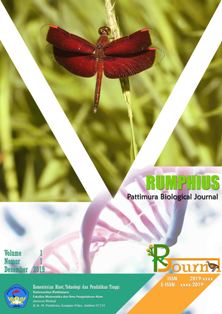Three Behaviors of Apis cerana Fabricius in Response to Supplementary Feed of Pulp and Paste of Tongka Langit Banana
Abstract
Apis cerana Fabricius is a honeybee commonly cultivated in Indonesia to produce honey. Additional feed can acts as a controller of honeybee colonies to protect them from migrate, in uncertain local weather conditions. Providing additional feed based on ‘tongka langit’ banana, Musa troglodytarum L. which have a high β-carotene nutritional content influences the adaptation, eating, and resting behaviors of Apis cerana. This study describes and analyses those three behaviors of Apis cerana to the provision of the feed. The study was conducted for 10 days with the provision of three treatment feeds, namely K+ (sugar water), P1 (fresh banana pulp), and P2 (banana paste) on the first day, and data collection was carried out the next day with a total of 5 times data collection on the number of individuals. Data represents for three types of behavior parameters (adaptation, eating, and resting) will be subjected to a two-way analysis of variance and continued with Duncan's test. Of the three treatments, result was found that P2 has the largest number of individuals in adaptation behavior, while in eating behavior it showed that K+ (as control) has the largest. Treatment K+ and P2 were also not significantly different, after Duncan’ comparison test. The number of individuals of resting behavior from P2 treatment observed on ninth day slightly increased to that of K+ treatment. This is reflected that P2 has potential as additional natural feed for Apis cerana, with high β-carotene content, then might inclusively turn to the honey, even in low levels.
Downloads
Copyright (c) 2024 Muchmin Hartanto

This work is licensed under a Creative Commons Attribution-NonCommercial-ShareAlike 4.0 International License.
Authors who propose a manuscript and have it approved for publication know that the manuscript will be registered and become part of the RPBJ. Authors and readers understand that this journal is open and all its contents can be accessed freely, provided that RPBJ is still listed as the source of information. The hope is that this journal can become a vehicle for exchange and scientific knowledge for society and the scientific community, especially in the field of Biology and other branches of science.









